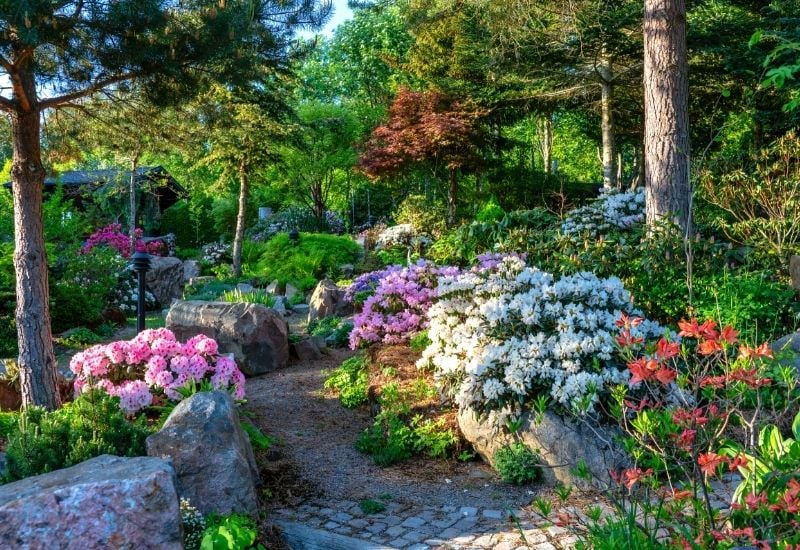
If your your soil is naturally acidic, defined as soil with a pH around 5.5, you might wonder which plants you can grow. While most plants grow best in a neutral or near-neutral soil pH, but there are some acid-loving plants, such as azalea, camellia, rhododendron, hydrangeas many conifers and magnolia tree that actually prefer to sink their roots in a naturally acidic soil .
And if you have one already and it looks “under the weather”, I understand you: it’s common, but you have to make a choice! Either you have to choose plants actually prefer acidic soil or lower the pH of soil to fit the plants.
Acid loving plants are technically called “acidophiles” and they are plants that love a low, acidic soil pH. From small flowering perennials to shrubs, very few vegetable, and even many evergreen trees are actually prefer slightly acidic soil pH below 5.5 to 6.5.
But they do require particular conditions, which you can achieve by “improving the soil” making it more acidic through tried and tested methods.
While a lower pH level won’t suitable for all plants, there are some that will naturally flourish in in soils that are acidic.
In this article, we will introduce 15 of our favorite acid-loving flowers, shrubs, fruits, and trees and their soil pH requirements.
But before we begin, let’s take a brief look at what exactly is an acid loving plant and what do we do if our garden does not have acidic soil?
What Is An Acid Loving Plant?
Acid loving plants, a.k.a. “acidophiles” or “acidophilic plants” are herbaceous, shrubs and tree species that grows best in acidic soil with a pH of 5.5 or lower.
The most common type of acid-loving plants include cedar trees, azaleas, rhododendrons, blueberry bushes, blackberries, cranberries and mushrooms (among others).
This is the definition, which may sound a bit generic. And in fact we need to make a few points, because there is some confusion online…
What Is Soil Acidity?
First of all we need to understand what soil acidity means. Soil can be acidic, alkaline or neutral, like all substances. This is measured on the pH scale, which goes from 0 to 14 for all substances in the world.
Low numbers are acidic, high numbers are alkaline and 7 is neutral. The lower the pH, the more acidic the substance.
But can soil get so low as to have 0 pH? No, it can’t. It can only get to 3.5 and at that level very, very few plants can survive. And it can only go up to 10. Even there, very few plants survive.
Also, we call soil neutral if it has a pH between 6.4 and 7.3.
But is every plant that can live with pH under 6.4 an acidophile? No, let me explain…
Acid Loving and Acid Tolerant Plants
An acid loving plant is different from an acid tolerant plant.
Acid loving plants are actually species that prefer acidic soil, and by this we normally mean quite acidic, like under 5.1. Azaleas, camellias, pine trees etc all really, really love the soil to be acidic.
Other plants may just tolerate fairly low pH (usually down to 5.1) but these are not called acid loving, these plants simply tolerate acidic soil, they don’t “love it”!
Be careful when you read online that for example broccoli or radish are acid loving… No, they absolutely prefer neutral and even alkaline soil: they will just “forgive you” if the soil is slightly acidic. But not too much.
In fact, vegetables mostly like alkaline soil and really prefer it to acidic soil, except potatoes.
Acid Loving Plants and Alkaline Soil
What is more most acid loving plants really cannot stand alkaline pH. This is especially true of shrubs and small plants. They will literally suffer and even die if the soil is even slightly alkaline. In some cases, like with azaleas, even neutral soil is too much for them!
So you see they are a bit particular, and that’s why we need to learn a few tricks, and here they are.
Key Rules To Growing Plants In Acid Soil
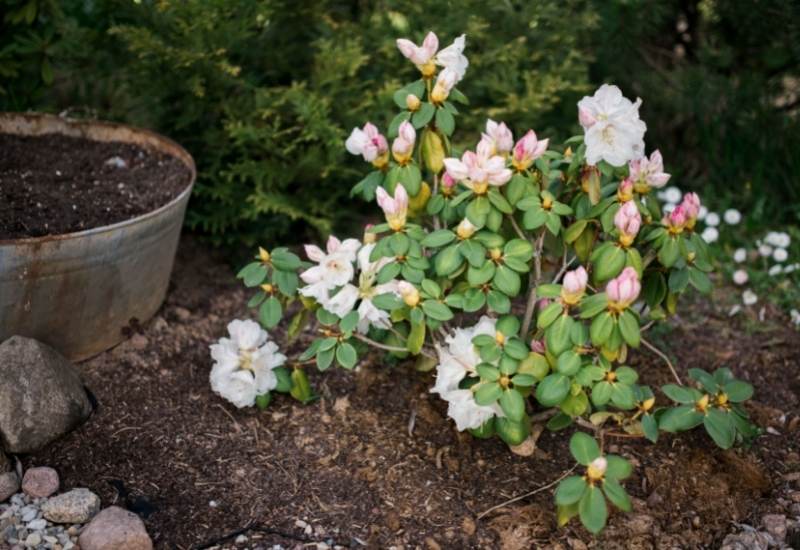
There is a reason why we have divided acid loving plants into groups: you need to treat them differently.
The fact is that some will even tolerate slightly alkaline soil, others will hardly forgive you if the soil is neutral, and finally there are others that will turn the soil acidic for you – actually for themselves!
Acid Loving Small Flowering Plants
In most cases, small acid loving perennials like heather or lily of the valley will not complain too much if the soil is neutral or even mildly alkaline. They will reduce their bloom and be more prone to disease, but on the whole they should manage.
Nevertheless, with these plants you should try to keep the soil acidic, maybe just adding some citrus peels, giving them the odd cup of tea or even using organic acidic fertilizer.
The matter become more complex with shrubs.
Acid Loving Flowering Shrubs
Acid loving flowering shrubs are the most challenging to grow. Think about which plants I am talking about: gardenias, rhododendrons, azaleas etc… You know they are high maintenance and few people are successful with them. And why?
Because these shrubs really cannot tolerate pH that’s even slightly alkaline, or at times even neutral. They will suffer (with leaf discoloring and bud blast) and stop growing and blooming. Eventually, they may even die.
Your best option is to acidify the soil before planting them. You can do it adding sulphur to the soil or for small spaces using acidic fertilizers, black tea, lemon and orange peels. These are often best grown in containers if your soil is seriously alkaline.
Berry bearing shrubs can be more forgiving than blooming plants, but still I would treat them as if they were flowering bushes.
Acid Loving Trees
Most conifers are acid loving trees, so are oaks, ashes and other big trees. These are different though from shrubs. They are far less delicate because they are trees. What do I mean? Trees can change the acidity of the soil to their liking!
Yes! This is one of the biggest discoveries in agriculture but also from an environmental point of view. Let’s say that trees are in charge of the whole ecosystem, and they do it by changing the soil into the type they like.
It takes time though, but at the beginning they will not mind alkaline soil at all. Plant a pine tree in alkaline soil and it may not start off as strong as in acidic soil, but it will still grow.
Then, over the years, it will transform the soil to match the low pH it likes… On one condition: that the soil is healthy and natural If you use any chemical fertilizers, insecticides and weed killers you will spoil your big tree’s efforts.
How to Care for Acid-Loving Plants
Acid loving plants will show you that the soil’s pH is too high for them. You will notice some symptom like leaf discoloring to light green and yellow, bud blast and stunted growth.
Bud blast in particular is common with acid loving shrubs: it means that the buds form but instead of opening, they dry up and turn brown. It also happens to roses, but for other causes.
A final tip… Acid loving plants also have thin and fairly weak roots. So, they cannot dig into hard soil, which is typically alkaline anyway.
They need very loose soil to grow their roots. Similarly, these roots can easily become ill with root rot if there is stagnant water around them.
Lots of drainage, like coarse sand then, if you want to please your acid loving plants!
15 Acid-Loving Plants That Grow Well in Acidic Soils
Small flowers, blooming shrubs, big trees and even a few crops – these plants are all different but they all have something in common: they love acidic soil.
Here are 15 of our favorite acid loving plants and flowers that will grow well in an acidic soil environment.
Small Flowering Acid Loving Plants
There are some tiny green beauties that love acidic soil and reward you with gracious and colorful blooms.
Many are quote famous too. These will often adapt to neutral soil without causing much trouble, and in fact they may be a good choice if you are new to plants that like low pH conditions.
Let’s take a tour of some of the best acid-loving flowers:
1. Heather (Erica spp.)

Heather is the “queen of the heath”, which of course is very acidic land… It will fill with its enormous blooms that last for weeks, in all its range from purple to white as long as the pH is under 5.5.
It is a classic of infertile, wind swept and acid lands of cold regions but for this reason it is also one of the strongest, hardiest and most dependable flowering shrublets you can ever grow!
Heather is excellent as ground cover, but really it adapts also to rock gardens and many other purposes, including pots and containers.
2. Cyclamen (Cyclamen spp.)

Many cyclamens like to grow in conifer forests, where the soil is loose and mildly acidic. And in fact they can be defined as “acid loving plants in moderation”.
Why? Well, anything below 5.5 is not ideal, but they will tolerate it down to 5.0. At the same time, they will not be enthusiastic about pH above 6.5.
With cyclamen you have a fairly adaptable flowering plant. You may not even need to improve the soil, only make sure it is very well drained. They will also propagate naturally in the right environment.
3. Periwinkle (Vinca minor and Vinca major)

Periwinkle is an ideal shade loving carpeting creeper for acidic soil. It will tolerate mildly alkaline soil too, but it really gives its best with fairly low pH.
The wonderful flowers that look like the propeller of a boat come in lavender, white and even pink and in two main sizes; lesser periwinkle (Vinca minor) is small and it grows naturally in many temperate forests. Big periwinkle (Vinca major) is more showy, suitable for beds and borders.
Choose which variety of periwinkle you like and grow it as a self spreading and carpeting plant to naturalize or as a lovely addition to informal beds or borders.
4. Lily of the Valley (Convallaria majalis)
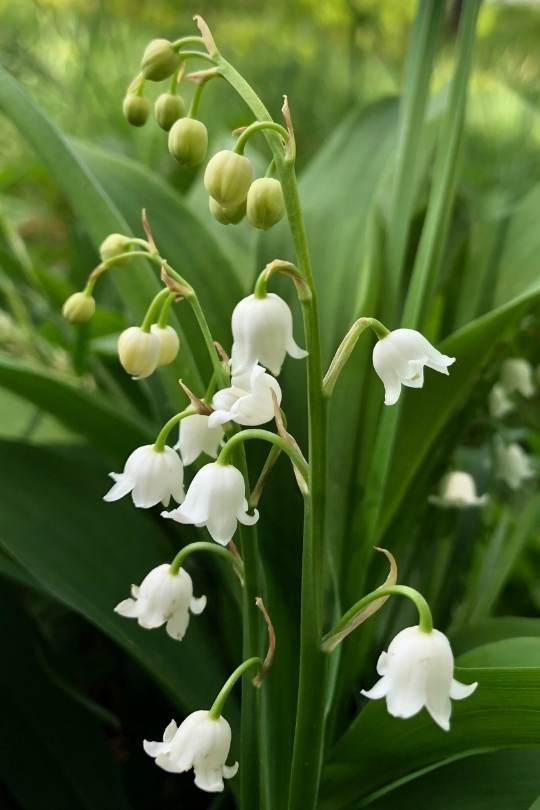
Acid loving lily of the valley has beautiful bell shaped flowers and lush decorative leaves that make great ground cover. You can see the pattern; small acid loving plants like to grow under trees, and lily of the valley is no exception.
There are a few varieties to choose from, like the beautifully striped ‘Albostriata’ or the long blooming ‘Bordeaux’.
Acid loving but toxic, lily of the valley is one of those plants you want in dappled shade as underbrush because it naturalizes very fast and it requires very low maintenance.
Flowering Shrubs That Grow Well in Acidic Soil
There are more acid loving flowering shrubs for gardens than small flowering plants. Unfortunately, acid loving flowering shrubs tend to be delicate and very particular about the acidity of the soil. While small plants may forgive you if the soil is a bit too alkaline, flowering shrubs won’t.
Typical signs that the soil is too alkaline for your acid loving shrub are:
Keeping these points in mind to make sure your plants are happy, here are some of the most famous acidophilic shrubs in the world!
5. Rhododendron and Azalea (Rhododendron spp.)

Acid loving rhododendron and azalea are some of the biggest gardening stars in history. Kew Gardens sent expeditions to the remotest regions of Asia and the Himalayas to find new species on the Nineteenth Century because this impressive bloomer became an all time favorite by gardeners.
Note that azaleas and rhododendrons are the same plant, only azaleas are small species in the same genus; it’s just a matter of size. They are actually part if how gardeners learned to grow acid loving plants, but they are not forgiving. They do need acidic soil or they will become ill very fast.
On the plus side, there are now so many varieties and cultivars that you can have a rainbow of brightly colored flowers and vast blooms just by growing these lovely acidophilic shrubs.
6. Camellia (Camellia spp.)
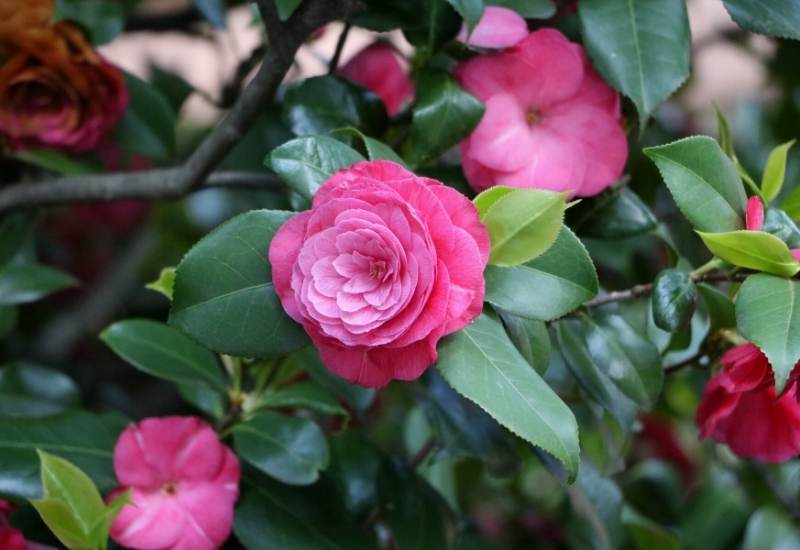
Beautiful, romantic and shade loving camellias also need acidic soil. And in fact the main reason why people fail to grow them is neutral or alkaline soil.
There are pink, white and red varieties of this soft looking and popular flower. The leaves are glossy, oval and dark green in color, and the shrubs are a real delight to look at.
Camellia is that plant that everybody would love to have but we are all scared to grow it; far too delicate. They turn yellow, the suffer from bud blast etc. far top easily.
In case, grow it in a pot; keep the acidity stable and make sure you find it a spot it likes in your garden. They are a bit picky about that too!
7. Gardenia (Gardenia spp.)
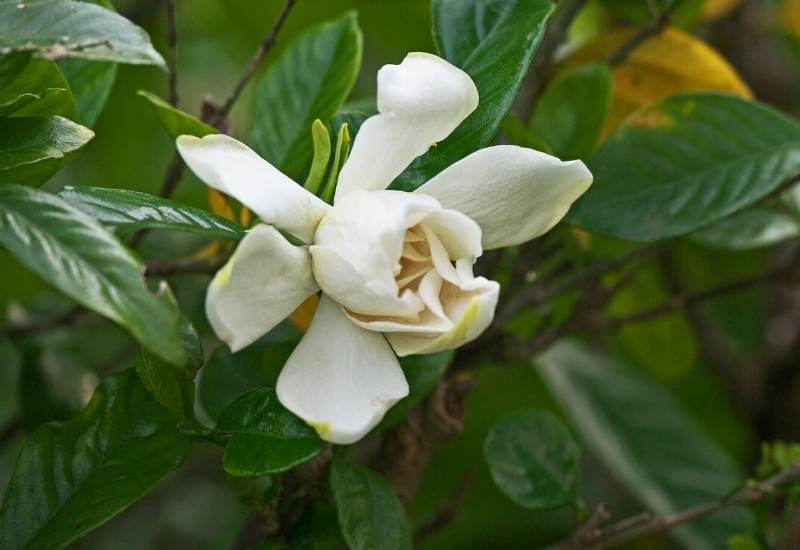
Gardenia, camellia, azalea and rhododendron are the four musketeer shrubs of the acid loving plant kingdom… Gardenias too are especially elegant, like camellias.
Their white double and single flowers have become iconic and synonymous with the art of gardening itself. And they too are quite particular about soil acidity.
If you want the candid blooms of gardenia in your green haven, this is a high maintenance plant, and it all starts with the quality and the acidity of the soil.
Maybe try it in containers first; it can make the tending to this delicate queen a bit more manageable.
8. Fothergilla (Fothergilla spp.)
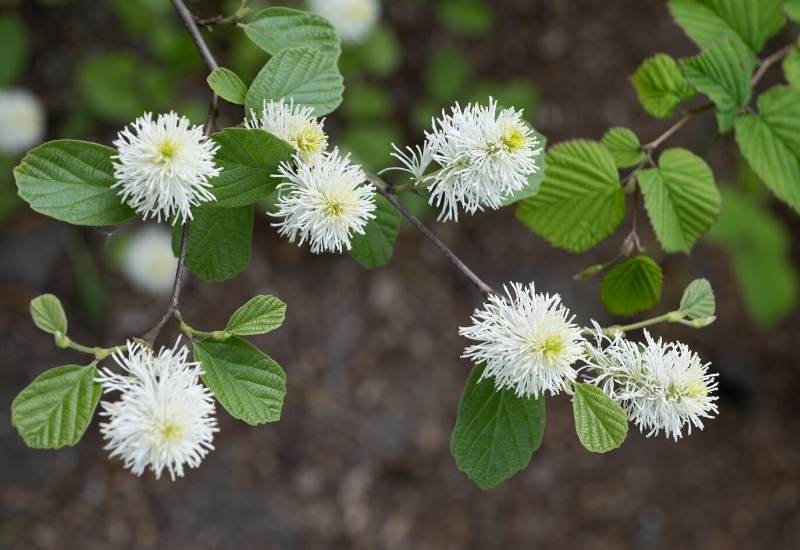
Fothergilla is a lesser known acid loving shrub with beautiful white inflorescences that look like bottle brushes… These come at the end of stems with bright green, oval and deeply veined leaves and they look up, towards the Sun.
maybe few people would correct the acidity of the soil to grow fothegilla, but it definitely is an easy plant to grow if your soil is from neutral to strongly acidic.
The leaves will turn gold and red in the fall, putting on quite a spectacular and emotional show.
It will be great in natural looking hedges or even borders, but it is not adaptable to formal settings. Even as a lovely shrub in a traditional English country garden it can do its part really well.
9. Blue Hydrangea (Hydrangea macrophylla)
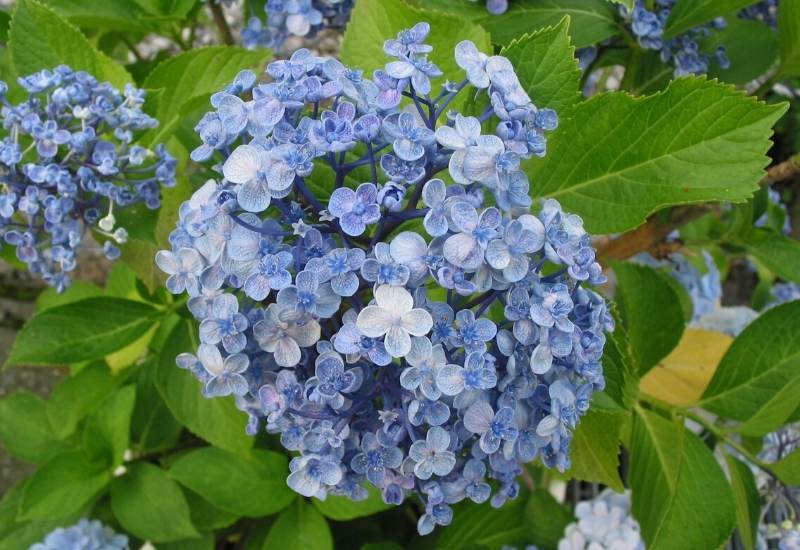
Do you want your blue hydrangea to blossom profusely and have a deep blue shade? They need acidic soil then! It’s a strange thing with these shade loving bushes… Most will manage with neutral and slightly acidic soil.
Hydrangeas do not like alkaline soil, they are quite acid loving… But blue hydrangeas more so than all others!
If your soil is already acidic, you have a chance to grow bright blue hydrangeas and wow your friends.
Instead if you planted a blue hydrangea and it came out with an uncertain shade, correct the acidity and next year it will be as blue as the sky!
Acid Loving Trees for Gardens With Acidic Soil
Acid loving trees are less problematic than shrubs; you can easily plant them in less than perfect soil pH and they will adapt first, then start acidifying the soil.
Remember that you need healthy soil, rich in microorganisms and especially micorrhizae for best results.
Smaller acid loving plants and shrubs like a spot of shade, you must have noticed. This is because in Nature they like to live close to acid loving trees that will lower the pH of the soil for them! You see how it works?
Let’s see some of the great acid loving trees to grow if your garden or landscape:
10. Oak (Quercus spp.)
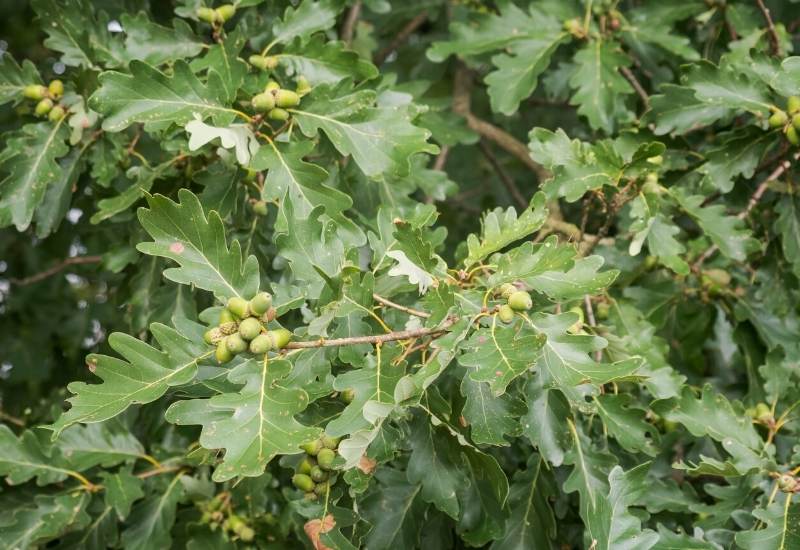
Oak is a large genus of deciduous trees and shrubs that like acidic soil on the whole. Some become giant and live for centuries, even millennia… Some species are particularly keen on soil acidity, like northern red oak (4.5 to 6.0), willow oak and water oak (3.6 to 6.3).
They are excellent to regenerate the soil and to change its texture and pH over time. They also create a whole environment, attracting all sorts of life, from fungi to animals that depend on them.
Planting an oak tree is a commitment; if you have a small garden, remember that this tree will be there long, long before you and even your grandchildren have gone. And it can become massive.
But in open fields where oaks used to grow spontaneous, everybody should plant some to re-establish the natural environment. They literally work miracles!
11. Holly (Ilex spp.)

Holly is can be an evergreen bush or tree and they they tend to like acidic soil. It is famous for its bright red berries and spikey leaves, which we use as Christmas decorations.
Holly trees and bushes are highly decorative and very common in gardens, they grow faster than oaks and they can be pruned into every shape and form. In fact you can use them for topiary.
You can grow holly just because you like it but if you want a fairly fast growing tree and shrub that will will lower your soil’s pH and you cannot wait for an oak tree to grow… Then go to a garden center and you will find a lot of holly varieties!
12. Magnolia (Magnolia spp.)

Magnolia is a magnificent flowering tree that loves acidic soil too! The large, glossy and sculptural leaves of this elegant and they can be either evergreen or deciduous.
The fragrant, white or cream, light yellow or even magenta flowers are a real spectacle. No wonder this is one of the most popular garden trees ever. But make sure you keep the soil pH between 5.0 and 6.0.
Magnolias are both elegant and sculptural at the same time. They also provide light shade but they do not block the sunlight completely.
There are many varieties and cultivars, even suitable for small gardens, like ‘Little Gem’ that will even grow in containers!
13. Scots Pine (Pinus sylvestris)
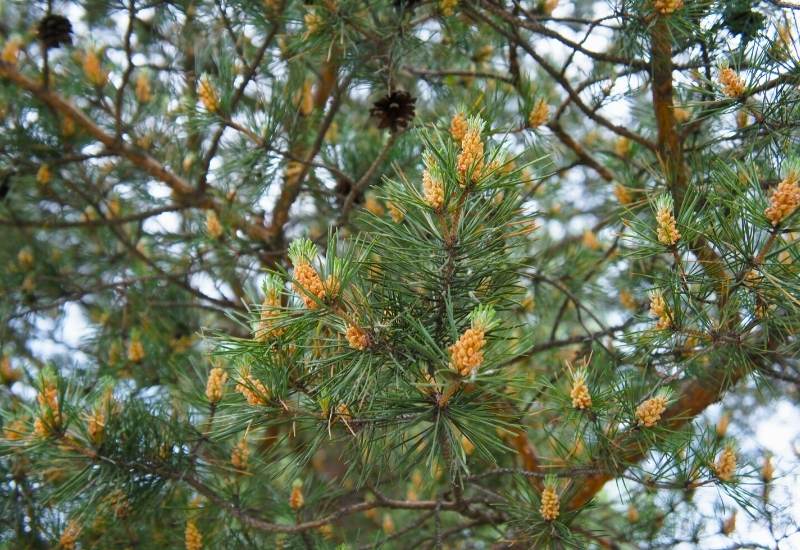
Scots pine is a classical looking evergreen conifer with conical shape and like all pines it like acidic soil. Other pines too want low soil pH, but this is both iconic and it likes it a bit more acidic than others.
Whether you want a Scots pine or another variety in your garden, these trees are excellent to lower soil pH. But there is a myth: pine needles do not acidify the soil.
By the time they fall they are basically neutral. It is the actual tree with its roots and with the help of micorrhizae that does the job.
Many pines are fast growing, so they can be a faster option than oak trees.
Acid Loving Fruit Crops
Very few fruits and vegetables even tolerate acidic soil; only potatoes go down the pH scale to 4.5. On the other hand, berry bearing plants will like acidic soil.
There’s a lot of acidity in blueberries or raspberries, for example, and they take it from the soil.
Let’s see a couple of examples, but all similar plants are acidophilic.
14. Blueberry (Vaccinium sect. Cyanococcus)
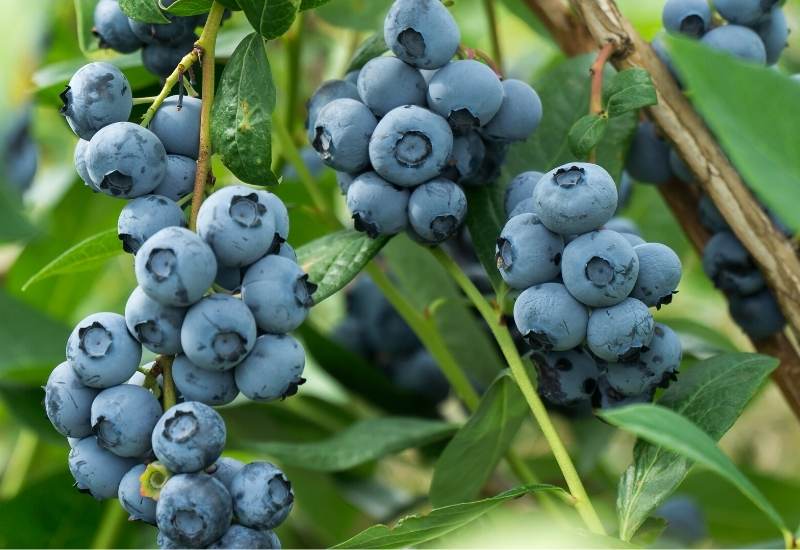
Blueberries love and give acidity, also in the form of vitamins! To be honest they are also pretty garden plants, with lovely drooping and well shaped flowers and then, of course, the super healthy, super delicious and super fresh berries are also nice to look at!
Growing blueberries is quite easy, despite what people think. There are also many varieties and good retailers will sell the best ones for your area… I would give it a go if I were you.
One thing though; you cannot expect blueberries to “create their won soil” like trees… You’ll have to prepare it for them!
15. Cranberry (Vaccinium macrocarpon)
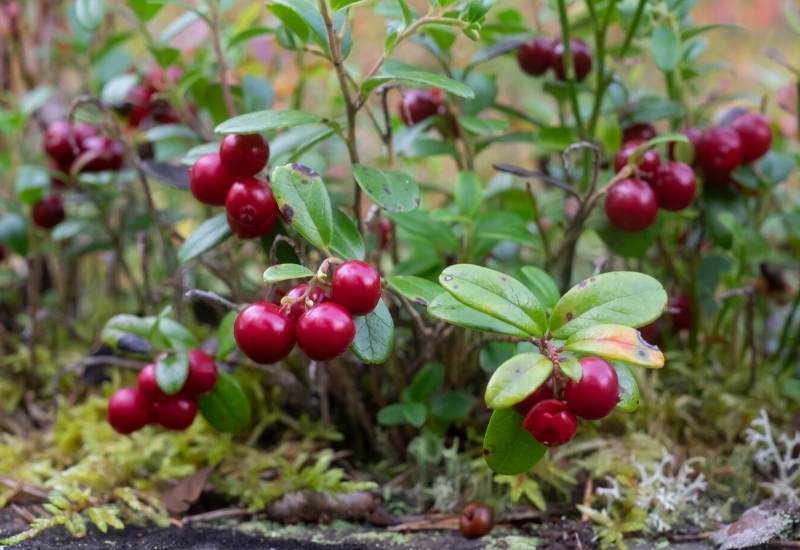
Cranberries are related to blueberries and like them they love acidic soil, but they are red. They are also very rich in vitamins and nutrients like their cousins. They are a bit more tricky to grow than blueberries but you can have a good crop in the right conditions.
You can grow them for food, but look at them… These creeping vines with lovely evergreen leaves and bright red berries are also excellent groundcover as well! And they are super cold hardy too…
Acid Loving Plants Without The Bitter Taste!
Acid loving plants are a bit special: they are a small group of plants especially when it comes to gardening and crops.
There are many that grow in the wilderness, but few we actually keep in gardens and even fewer in vegetable patches.
You need to prepare the soil for some of them, correcting acidity and texture; for others, it’s the other way round: acid loving trees will do all the work for you. But you need to give them time!
But now you know all the tricks of the trade, you can grow challenging acid loving plants without ending up with a sour taste in your mouth!

Written By
Amber Noyes
Amber Noyes was born and raised in a suburban California town, San Mateo. She holds a master’s degree in horticulture from the University of California as well as a BS in Biology from the University of San Francisco. With experience working on an organic farm, water conservation research, farmers’ markets, and plant nursery, she understands what makes plants thrive and how we can better understand the connection between microclimate and plant health. When she’s not on the land, Amber loves informing people of new ideas/things related to gardening, especially organic gardening, houseplants, and growing plants in a small space.

Helpful article as to what to do with my garden space which is bordered by a row of spruce trees and also has no sun for a good part of the day. I live in Windsor, Ontario, hardiness zone 7a. Can’t wait to try blueberries, and some flowering shrubs. Thanks for all the suggestions.